Spatial Distribution and Future Projections of Thermal Comfort Conditions during the Hot Period of the Year in Diyarbakır City, Southeastern Turkey
Abstract
1. Introduction
2. Materials and Methods
General Physical Geography Features
- TMRT—mean radiant temperature (°C);
- K*abs—sum of all absorbed shortwave radiant flux densities (W∙m2);
- L*abs—sum of all absorbed long wave radiant flux densities (W∙m2);
- ε—emission power of the human body (0.97);
- σ—Stefan–Boltzmann constant (5.67 × 10−8 W∙m2∙K4) [60].
3. Results
3.1. Urbanization, Population Characteristics, and Projections of Diyarbakır City
3.2. Current Spatial Distribution of Thermal Comfort Conditions
3.3. Projected Thermal Comfort Conditions in the Near Future (2021–2050)
3.4. Projected Thermal Comfort Conditions in the Distant Future (2071–2100)
3.5. Percentages of Spatial Distribution of Thermal Comfort Conditions
4. Discussion
5. Conclusions
Author Contributions
Funding
Institutional Review Board Statement
Informed Consent Statement
Data Availability Statement
Conflicts of Interest
References
- Bonacina, L.C.W. Landscape meteorology and its reflection in art and literature. Q. J. R. Meteorol. Soc. 1939, 65, 485–498. [Google Scholar] [CrossRef]
- Neuberger, H. Climate in art. Weather 1970, 25, 46–56. [Google Scholar] [CrossRef]
- Charalampopoulos, I.; Matzarakis, A. Thoughts about the thermal environment and the development of human civilisation. Atmosphere 2022, 13, 1925. [Google Scholar] [CrossRef]
- Türkes, M. What does the intergovernmental panel on climate change (IPCC)’s newly released climate change impacts; adaptation and vulnerability report tell us? J. Resil. 2022, 6, 197–207. [Google Scholar]
- Schlegel, I.; Muthers, S.; Mücke, H.; Matzarakis, A. Comparison of respiratory and ischemic heart mortalities and their relationship to the thermal environment. Atmosphere 2020, 11, 826. [Google Scholar] [CrossRef]
- Yi, C.; Yang, H. Heat Exposure information at screen level for an impact-based forecasting and warning service for heat-wave disasters. Atmosphere 2020, 11, 920. [Google Scholar] [CrossRef]
- Ruuhela, R.; Votsis, A.; Kukkonen, J.; Jylhä, K.; Kankaanpää, S.; Perrels, A. Temperature-related mortality in helsinki compared to its surrounding region over two decades, with special emphasis on intensive heatwaves. Atmosphere 2021, 12, 46. [Google Scholar] [CrossRef]
- Matzarakis, A.; Cheval, S.; Lin, T.-P.; Potchter, O. Challenges in applied human biometeorology. Atmosphere 2021, 12, 296. [Google Scholar] [CrossRef]
- Çağlak, S.; Matzarakis, A. Evaluation of the relationship between thermal comfort conditions and respiratory diseases in Amasya City, Turkey. J. Public Health 2023. online version. [Google Scholar] [CrossRef]
- IPCC. Climate Change: Impacts, adaptation and vulnerability. Contribution of working group II to the sixth assessment report of the intergovernmental panel on climate change. In Summary for Policymaker; Pörtner, H., Ed.; Cambridge University Press: Cambridge, UK, 2022. [Google Scholar]
- IPCC. Climate Change: Mitigation of climate change. Contribution of working group II to the sixth assessment report of the ıntergovernmental panel on climate change. In Summary for Policymaker; Skea, A., Ed.; Cambridge University Press: Cambridge, UK, 2022. [Google Scholar]
- Türkes, M. Climate diplomacy and political economy of climate change. Sci. Utop. 2022, 332, 31–45. [Google Scholar]
- Lerner, D. The Passing of Traditional Society Modernizing the Middle East; Free Press: New York, NY, USA, 1964; 466p. [Google Scholar]
- Mayer, H. Urban bioclimatology. Experientia 1993, 49, 957–963. [Google Scholar] [CrossRef] [PubMed]
- Unger, J. Urban–rural air humidity differences in Szeged, Hungary. Int. J. Climatol. 1999, 19, 1509–15015. [Google Scholar] [CrossRef]
- Charalampopoulos, I.; Tsiros, I.; Sereli, A.; Matzarakis, A. Analysis of thermal bioclimate in various urban configurations in Athens, Greece. Urban Ecosyst. 2013, 16, 217–233. [Google Scholar] [CrossRef]
- Toy, S.; Çağlak, S.; Esringü, A. Assessment of bioclimatic sensitive spatial planning in a Turkish city, Eskisehir. Atmosfera 2021, 35, 719–735. [Google Scholar] [CrossRef]
- Olgyay, V. Design with Climate, Bioclimatic Approach to Architectural Regionalism; Princeton University Press: Princeton, NJ, USA, 1973; 224p. [Google Scholar]
- Çağlak, S. The Effects and Possible Consequences of Climate Change on Bioclimatic Comfort Conditions. Ph.D. Thesis, Ondokuz Mayıs University, Samsun, Turkey, 2021. [Google Scholar]
- Nastos, P.T.; Giaouzaki, K.N.; Kampanis, N.A.; Matzarakis, A. Acute coronary syndromes related to bio-climate in a Mediterranean area. The Case of Ierathıra, Crete Island, Greece. Int. J. Environ. Health Res. 2013, 23, 76–90. [Google Scholar] [CrossRef] [PubMed]
- Nastos, P.T.; Matzarakis, A. The effect of air temperature and human thermal indices on mortality in Athens, Greece. Theor. Appl. Climatol. 2011, 3, 591–599. [Google Scholar] [CrossRef]
- Scherber, K.; Langner, M.; Endlicher, W. Spatial analysis of hospital admissions for respiratory diseases during summer months in Berlin taking bioclimatic and socio-economic aspects into account. J. Geogr. Soc. Berl. 2014, 144, 217–237. [Google Scholar]
- Huang, F.; Zhao, A.; Chen, R.J.; Kan, H.D.; Kuang, X.Y. Ambient temperature and outpatient visits for acute exacerbation of chronic bronchitis in Shanghai: A time series analysis. Biomed. Envorn. Sci. 2015, 28, 76–79. [Google Scholar]
- Blazejczyk, K.; Baranowski, J.; Blazejczyk, A. Climate related diseases. Current regional variability and projections to the year 2100. Quaest. Geogr. 2018, 37, 23–36. [Google Scholar] [CrossRef]
- Aboubakri, O.; Kahnjani, N.; Jahani, Y.; Bakhtiari, B. Thermal comfort and mortality in a dry region of Iran, Kerman; a 12-year time series analysis. Theor. Appl. Climatol. 2020, 139, 403–413. [Google Scholar] [CrossRef]
- Tabari, H. Climate change impact on flood and extreme precipitation increases with water availability. Sci. Rep. 2020, 10, 137–168. [Google Scholar] [CrossRef] [PubMed]
- Trenberth, K.; Dai, A.; van der Schrier, G.; Jones, P.D.; Barichivich, J.; Brifta, K.R.; Sheffield, J. Global warming and changes in drought. Nat. Clim. Change 2014, 4, 17–22. [Google Scholar] [CrossRef]
- Rossiello, M.R.; Szema, A. Health effects of climate change-induced wildfires and heatwaves. Cureus 2019, 11, e4771. [Google Scholar] [CrossRef]
- Sweileh, W.M. Bibliometric analysis of peer-reviewed literature on climate change and human health with an emphasis on infectious diseases. Glob. Health 2020, 16, 44–58. [Google Scholar] [CrossRef]
- Oke, T.R. City size and the urban heat island. Atmos. Environ. 1973, 7, 769–779. [Google Scholar] [CrossRef]
- Karl, T.R.; Diaz, H.H.; Kukla, G. Urbanization: Its detection and effect in the United States climate record. J. Clim. 1988, 1, 1099–1123. [Google Scholar] [CrossRef]
- Fortuniak, K.; Kłysik, K.; Wibig, J. Urban—Rural contrasts of meteorological parameters in Łódź. Theor. Appl. Climatol. 2006, 84, 91–101. [Google Scholar] [CrossRef]
- Bonacquisti, V.; Casale, G.R.; Palmieri, S.; Siani, A.M. A canopy layer model and its application to Rome. Sci. Total Environ. 2006, 364, 1–13. [Google Scholar] [CrossRef] [PubMed]
- Gulyás, Á.; Matzarakis, A.; Unger, J. Comparison of the urban-rural comfort sensation in a city with warm continental climate. Ber. Meteorol. Inst. Albert-Ludwigs-Univ. Freibg. 2010, 20, 473–478. [Google Scholar]
- Algeciras, J.R.; Tablada, A.; Matzarakis, A. Effect of asymmetrical street canyons on pedestrian thermal comfort in warm-humid climate of Cuba. Theor. Appl. Climatol. 2018, 133, 663–679. [Google Scholar] [CrossRef]
- Bulut, Y.; Toy, S.; Irmak, M.A.; Yılmaz, H.; Yılmaz, S. Urban-rural climate differences during the 2-year period in Erzurum province. Atmosfera 2008, 21, 121–133. [Google Scholar]
- Çalışkan, O.; Türkoğlu, N. The trend of thermal comfort conditions and the effect of urbanization on thermal comfort conditions in Ankara. J. Geogr. Sci. 2014, 12, 119–132. [Google Scholar]
- Brecht, B.M.; Schadler, G.; Schipper, J.W. UTCI climatology and its future change in Germany—An RCM ensemble approach. Meteorol. Z. 2020, 29, 97–116. [Google Scholar] [CrossRef]
- Chen, G.; Li, X.; Liu, X.; Chen, Y.; Liang, X.; Leng, J.; Xu, X.; Liao, W.; Qiu, Y.; Wu, Q.; et al. Global projections of future urban land expansion under shared socioeconomic pathways. Nat. Commun. 2020, 11, 537. [Google Scholar] [CrossRef] [PubMed]
- Cheung, C.S.C.; Hart, M.A. Climate change and thermal comfort in Hongkong. Int. J. Biometeorol. 2014, 58, 137–148. [Google Scholar] [CrossRef]
- Matzarakis, A.; Endler, C. Climate change and thermal bioclimate in cities: Impacts and options for adaptation in Freiburg, Germany. Int. J. Biometeorol. 2010, 54, 479–483. [Google Scholar] [CrossRef]
- Nastos, P.T.; Matzarakis, A. Present and future climate—Tourism conditions in Milos Island, Greece. Atmosphere 2019, 10, 97–107. [Google Scholar] [CrossRef]
- Larsen, S.F.; Filippín, C.; Barea, G. Impact of climate change on energy use and bioclimatic design of residential buildings in the 21st century in Argentina. Energy Build. 2019, 184, 216–229. [Google Scholar] [CrossRef]
- Şensoy, S.; Türkoğlu, N.; Çiçek, İ.; Matzarakis, A. Thermal comfort features of Antalya, future projections using climate model data and its effects on tourism. Turk. J. Geogr. Sci. 2020, 18, 124–160. [Google Scholar]
- Kum, G.; Gönençgil, B. Tourism climate comfort of Turkey’s Southwestern Seasides. Gaziantep Univ. J. Soc. Sci. 2018, 17, 70–87. [Google Scholar] [CrossRef]
- Çağlak, S. Spatial distribution of bioclimatic comfort conditions of Amasya city and future projections. Mavi Atlas 2022, 10, 182–197. [Google Scholar] [CrossRef]
- Çağlak, S.; Türkeş, M. Analysis of spatial distribution of thermal comfort conditions in current and future climate conditions with a new approach; Bolu city example. Turk. J. Geogr. Sci. 2022, 20, 338–358. [Google Scholar]
- Öztürk, T.; Turp, M.T.; Türkeş, M.; Kurnaz, M.L. Future projections of temperature and precipitation climatology for CORDEX-MENA domain using RegCM4.4. Atmos. Res. 2018, 206, 87–107. [Google Scholar] [CrossRef]
- Erlat, E.; Türkeş, M. Observed changes and trends in numbers of summer and tropical days, and the 2010 hot summer in Turkey. Int. J. Climatol. 2013, 33, 1898–1908. [Google Scholar] [CrossRef]
- Bekleyen, A.; Dalkiliç, N. The influence of climate and privacy on indigenous courtyard houses in Diyarbakır, Turkey. Sci. Res. Essays 2011, 6, 908–922. [Google Scholar]
- Karadoğan, S.; Drahor, M.G.; Kuzucuoğlu, C. Using geophysical techniques in geomorphological problems: A case study from Kavs Flat in Dicle Valley (South of Diyarbakır). J. Geogr. 2020, 40, 307–322. [Google Scholar]
- Yılmaz, E.; Çiçek, İ. Detailed Köppen-Geiger climate regions of Turkey. Int. J. Hum. Sci. 2018, 15, 225–242. [Google Scholar]
- Buchhorn, M.; Smets, B.; Bertels, L.; De Roo, B.; Lesiv, M.; Tsendbazar, N.E.; Linlin, L.; Tarko, A. Copernicus Global Land Service; Land Cover 100 m, Version 3 Globe 2015–2019, Product User Manual; Zenodo: Geneve, Switzerland, 2020; 44p. [Google Scholar]
- Gao, J.; Pesaresi, M. Downscaling SSP-consistent Global Spatial Urban Land Projections from 1/8-degree to 1-km Resolution 2000–2100. Sci. Data 2021, 8, 281. [Google Scholar] [CrossRef]
- O’Neill, B.C.; Tebaldi, C.; Van Vuuren, D.; Eyring, V.; Friedlingstein, P.; Hurtt, G.; Knutti, R.; Kriegler, E.; Lamarque, J.F.; Lowe, J.; et al. The scenario model intercomparison project (ScenarioMIP) for CMIP6. Geosci. Model Dev. 2016, 9, 3461–3482. [Google Scholar] [CrossRef]
- Höppe, P. The Physiological Equivalent Temperature—A Universal Index for The biometeorological assessment of the thermal environment. Int. J. Biometeorol. 1999, 43, 71–75. [Google Scholar] [CrossRef]
- Matzarakis, A.; Mayer, H.; Iziomon, M.G. Applications of a Universal Thermal Index: Physiological Equivalent Temperature. Int. J. Biometeorol. 1999, 43, 76–84. [Google Scholar] [CrossRef]
- Gulyas, A.; Unger, J.; Matzarakis, A. Assessment of the micro climatic and human comfort conditions in a complex urban environment: Modelling and measurements. Build. Environ. 2006, 4, 1713–1722. [Google Scholar] [CrossRef]
- Höppe, P. Die Energiebilanz des Menschen; Meteorologisches Institut, Universität München: München, Germany, 1984; 49. [Google Scholar]
- Cohen, S.; Palatchi, Y.; Palatchi, D.P.; Bar, L.S.; Lukyanov, V.; Yaakov, Y.; Matzarakis, A.; Tanny, J.; Potcher, O. Mean radiant temperature in urban canyons from solar calculations, climate and surface properties—Theory, validation and ‘Mr.T’ software. Build. Environ. 2020, 178, 106927. [Google Scholar] [CrossRef]
- Çağlak, S.; Bahadir, M.; Toy, S. Monitoring the Past and Future Trends of Urban Thermal Comfort Conditions through a New Methodology. Glob. Soc. Welf. 2023. online version. [Google Scholar] [CrossRef]
- Steeneveld, G.J.; Koopmans, S.; Heusinkveld, B.G.; Hove, L.W.A.; Holstlag, A.A.M. Quantifying urban heat ısland effects and human comfort for cities of variable size and urban morphology in the Netherlands. J. Geophys. Res. 2020, 116, 1–14. [Google Scholar] [CrossRef]
- Koopmans, S.; Ronda, R.; Steeneveld, G.J.; Holstlag, A.A.M.; Tank, A.M.G. Quantifying the effect of different urban planning strategies on heat stress for current and future climates in the agglomeration of the Hague (The Netherlands). Atmosphere 2018, 9, 353. [Google Scholar] [CrossRef]
- Perkhurova, A.A.; Konstantinov, P.I.; Varentsov, M.I.; Shartova, N.I.; Samsonov, T.E.; Krainov, V.N. Real-time microscale modeling of thermal comfort conditions in Moscow Region. IOP Conf. Ser. Earth Environ. Sci. 2019, 386, 012046. [Google Scholar] [CrossRef]
- Koopmans, S.; Heusinkveld, B.G.; Steeneveld, G.J. A Standardized Physical Equivalent Temperature Urban heat map at 1-m spatial resolution to facilitate climate stress tests in the Netherlands. Build. Environ. 2020, 181, 012046. [Google Scholar] [CrossRef]
- Troen, I.; Petersen, E. European Wind Atlas; National Laboratory: Roskilde, Denmark, 1989; 656p. [Google Scholar]
- Arslaner, H.; Yavan, S. Local Public Service Delivery Differences Brought by Law No. 6360. Anadolu Univ. J. Soc. Sci. 2016, 2016, 277–290. [Google Scholar]
- Aksu, R.; Değerliyurt, M. Planning a model of settlement areas in order to provide a sustainable urban development: Diyarbakir case. In Proceedings of the Tucaum viii. Geography Symposium, Ankara, Turkey, 23–24 October 2014. [Google Scholar]
- Kosztra, B.; Büttner, G.; Hazeu, G.; Arnold, S. Updated CLC Illustrated Nomenclature Guidelines; European Enviroment Agency: Wien, Austria, 2019; 126p. [Google Scholar]
- Clarke, J.F.; Bach, W. Comparison of the comfort conditions in different urban and suburban microenvironments. Int. J. Biometeorol. 1971, 15, 41–54. [Google Scholar] [CrossRef]
- Vitt, R.; Gulyas, A.; Matzarakis, A. Temporal differences of urban-rural human biometeorological factors for planning and tourism in Szeged, Hungary. Adv. Meteorol. 2015, 2015, 987576. [Google Scholar] [CrossRef]
- Svensson, M.K.; Eliasson, I. Diurnal air temperatures in built-up areas in relation to urban planning. Landsc. Urban Plan. 2002, 61, 37–54. [Google Scholar] [CrossRef]

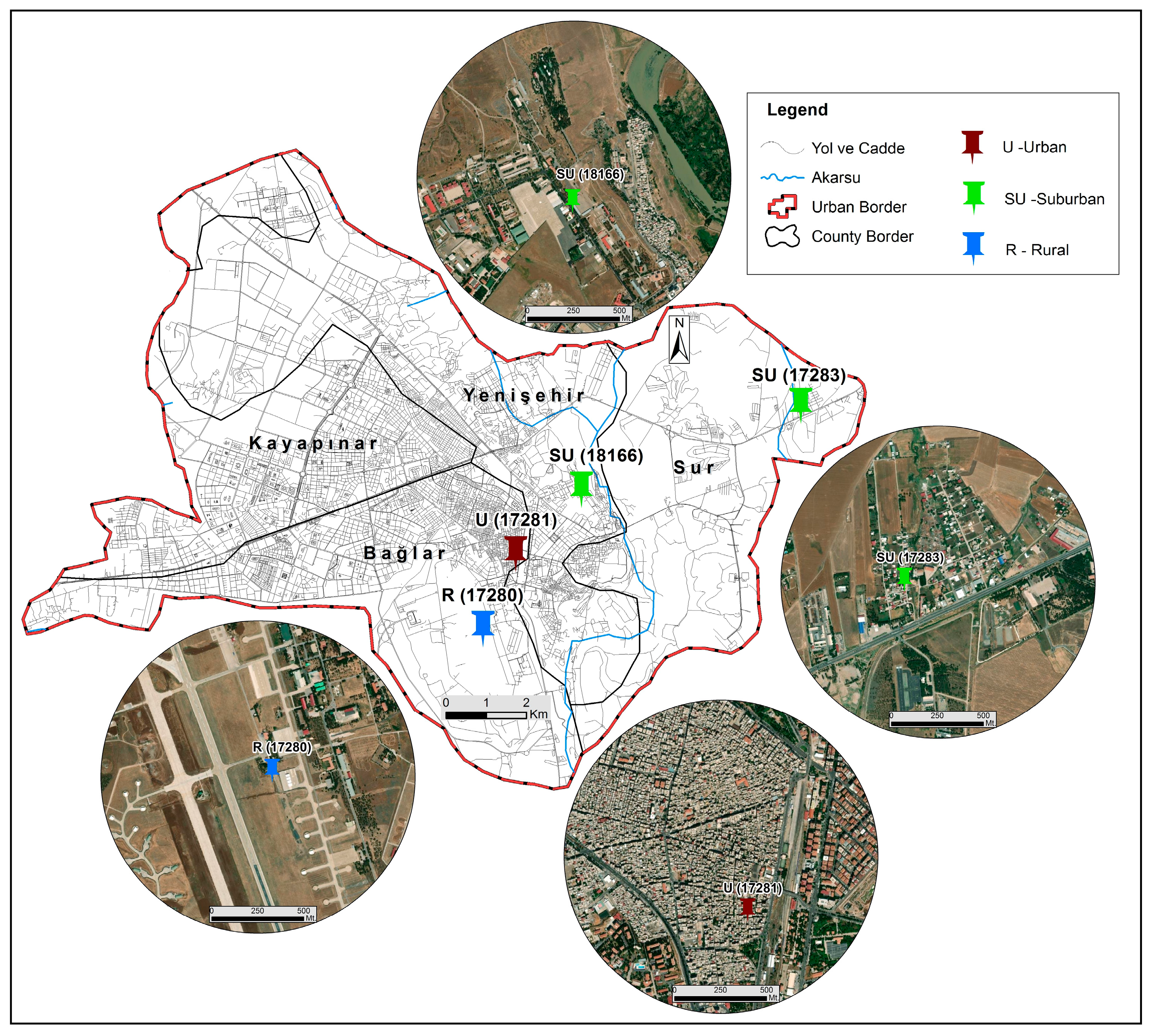
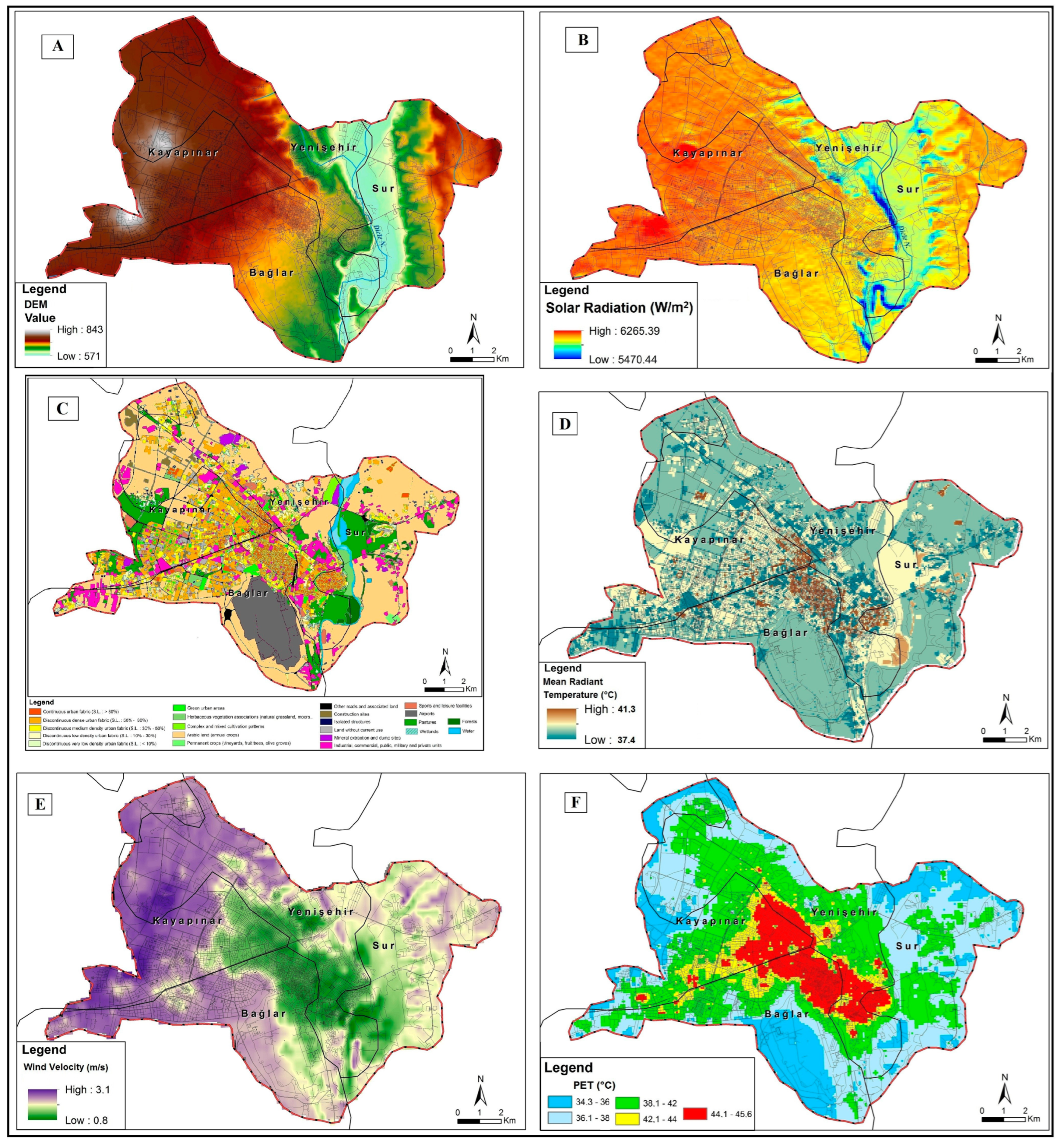
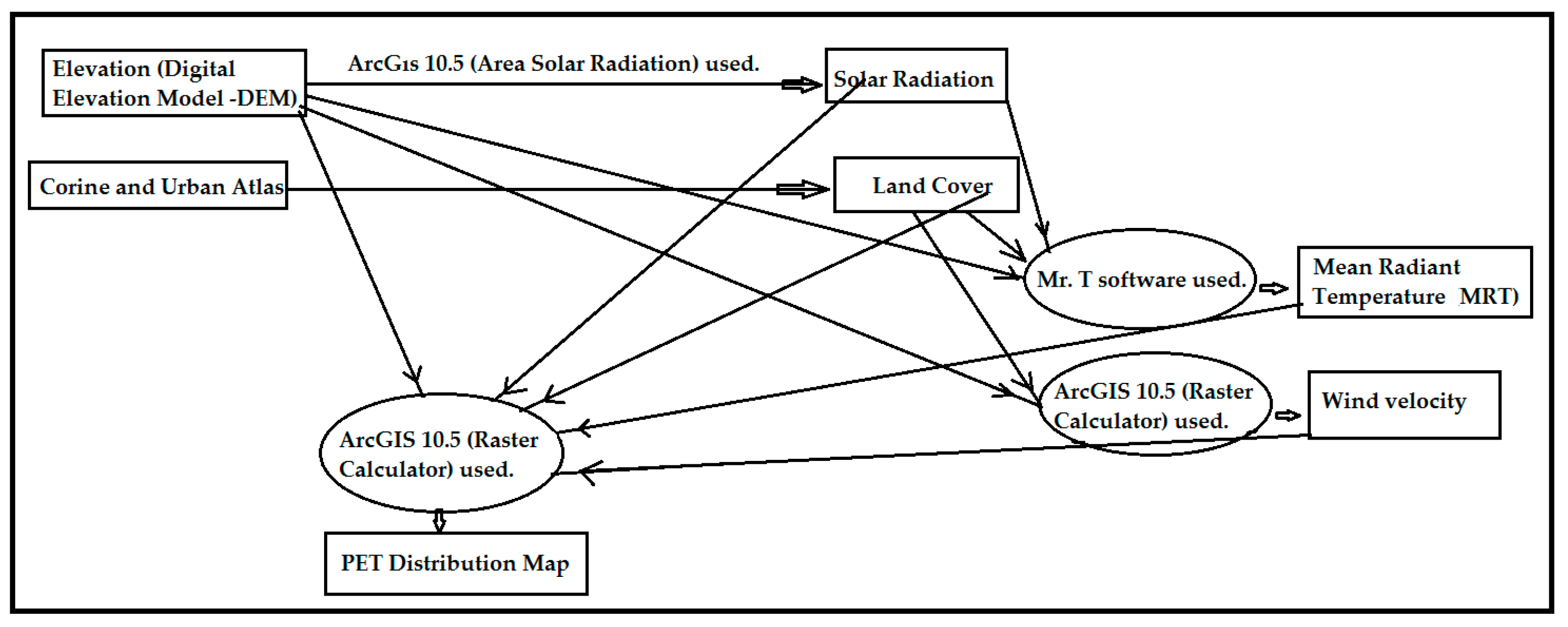
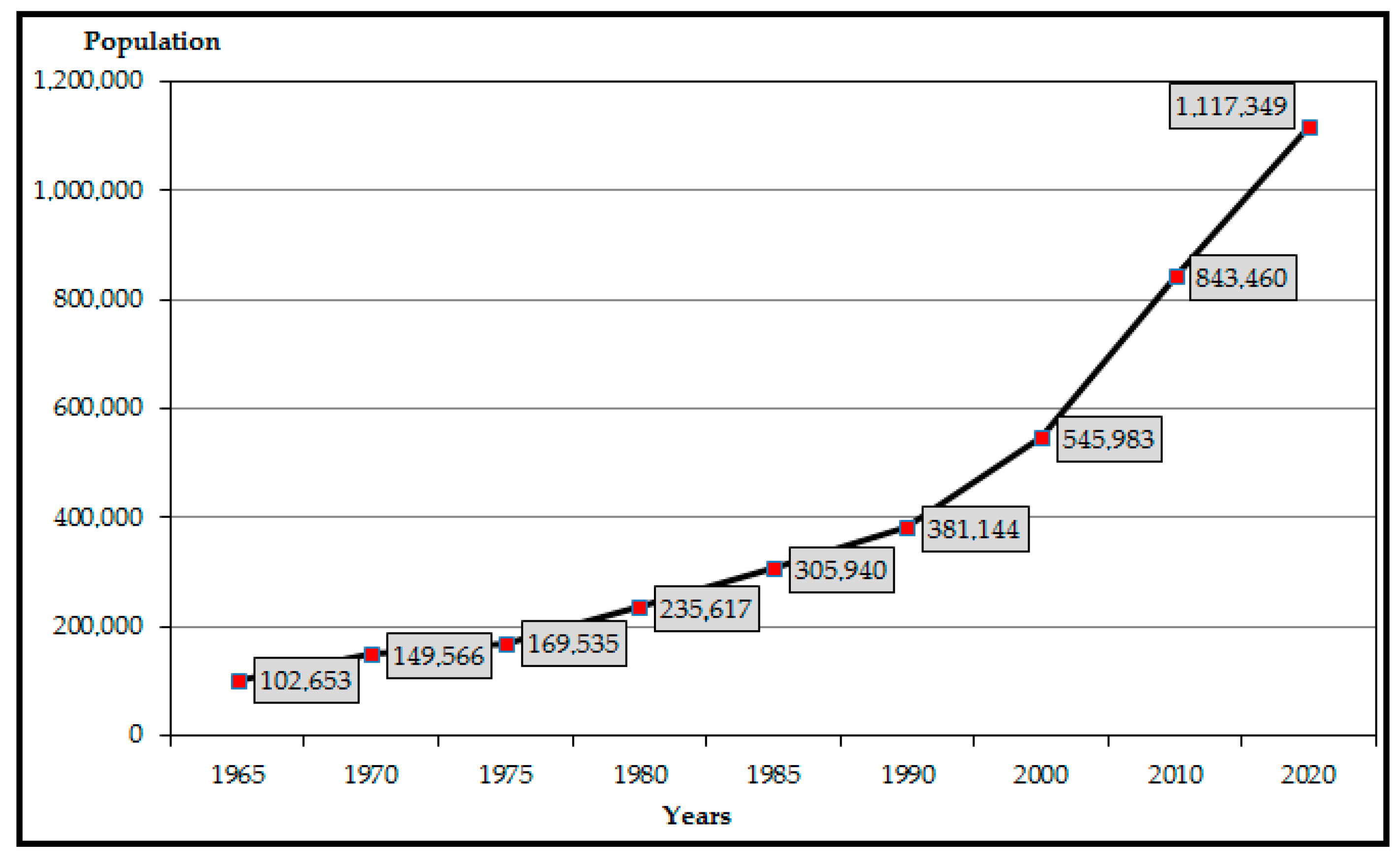
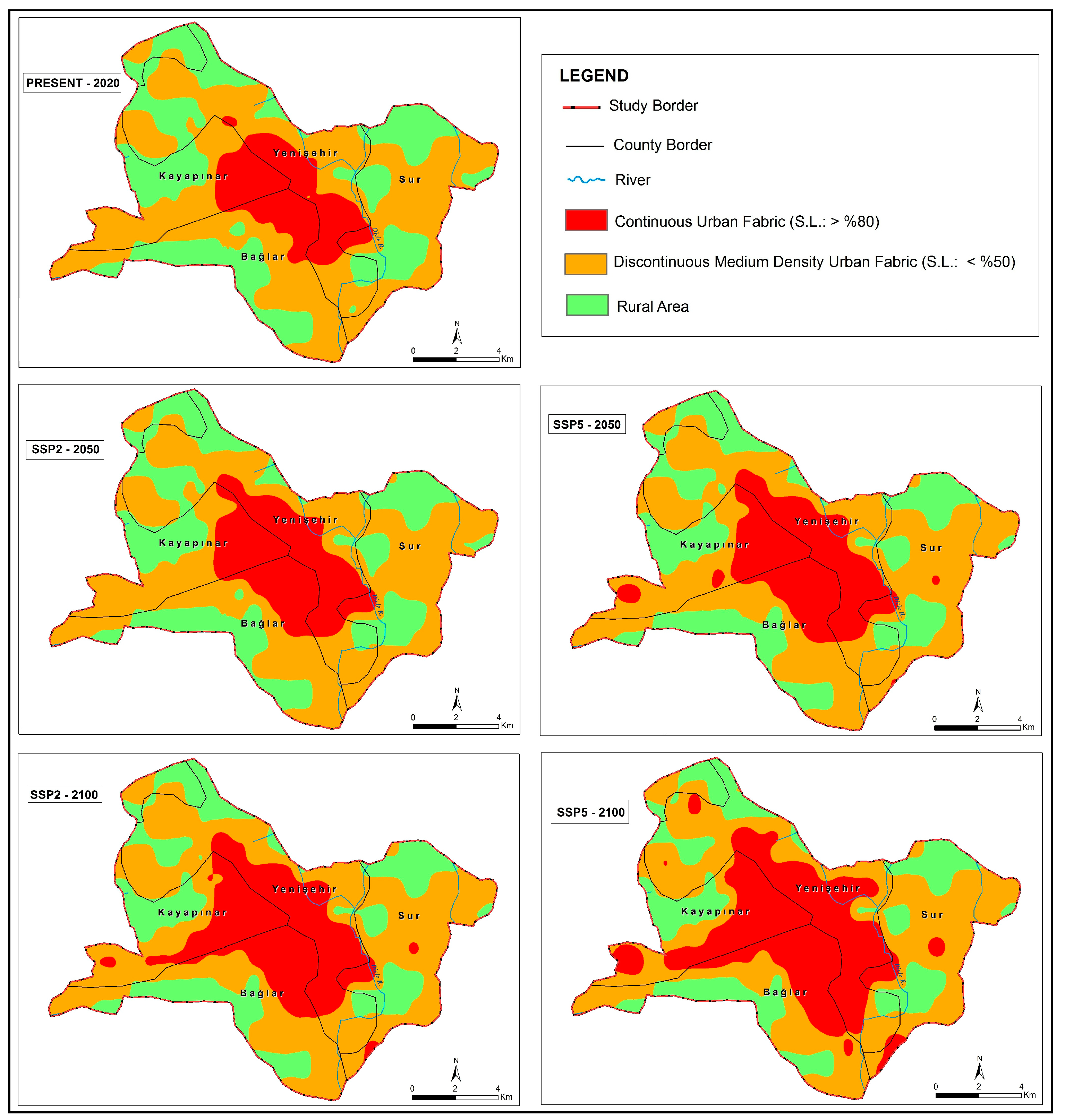
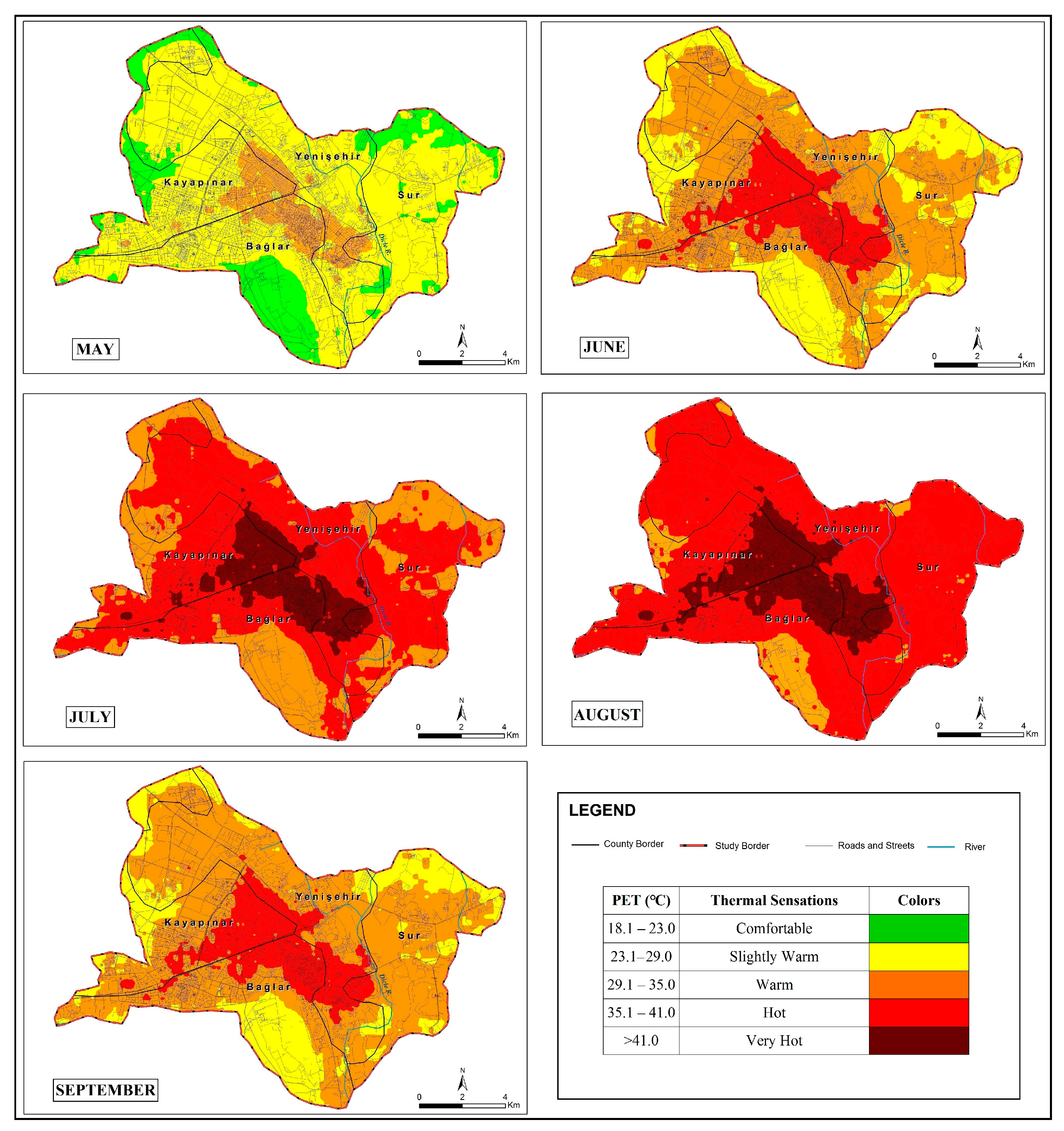

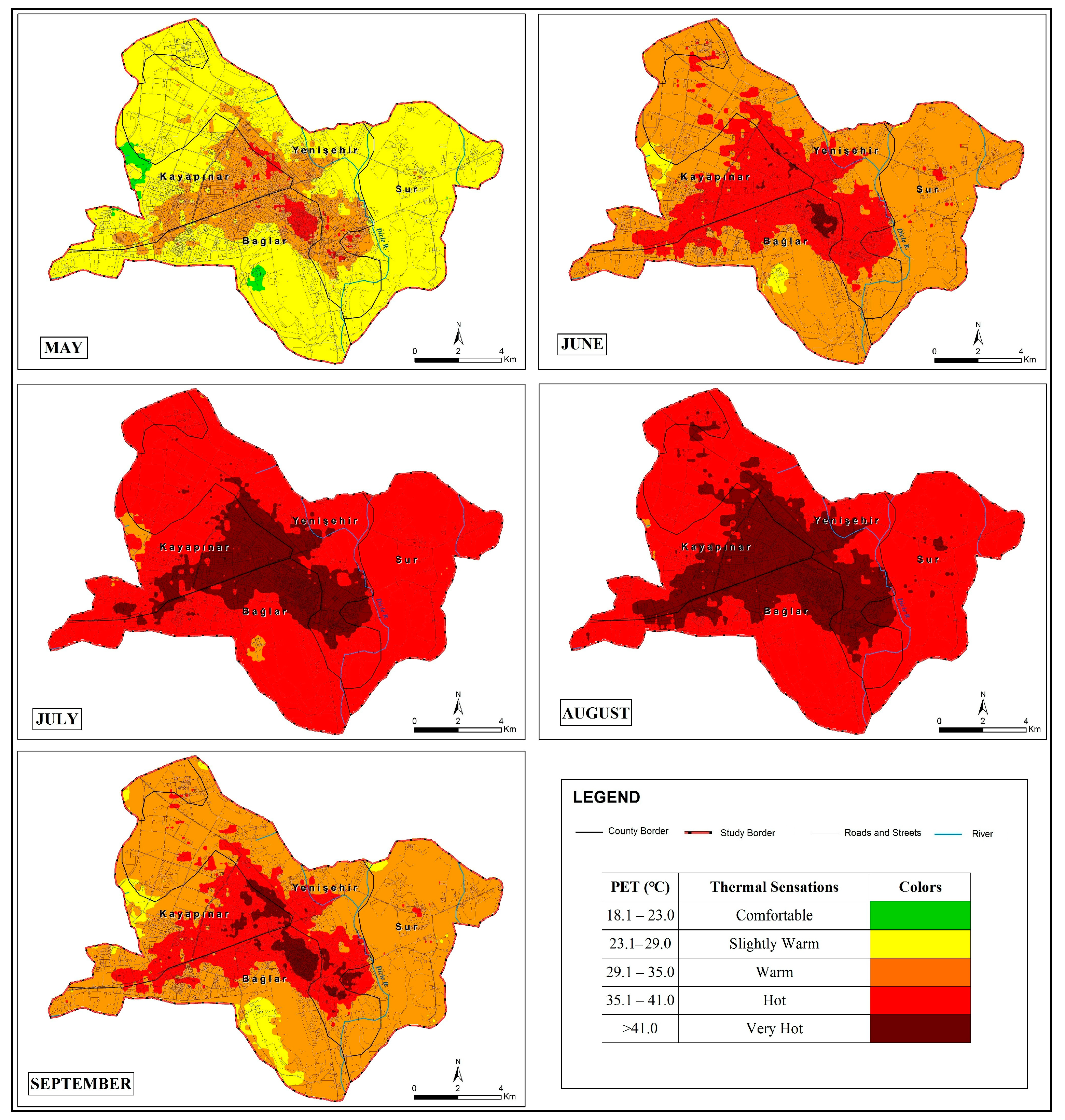
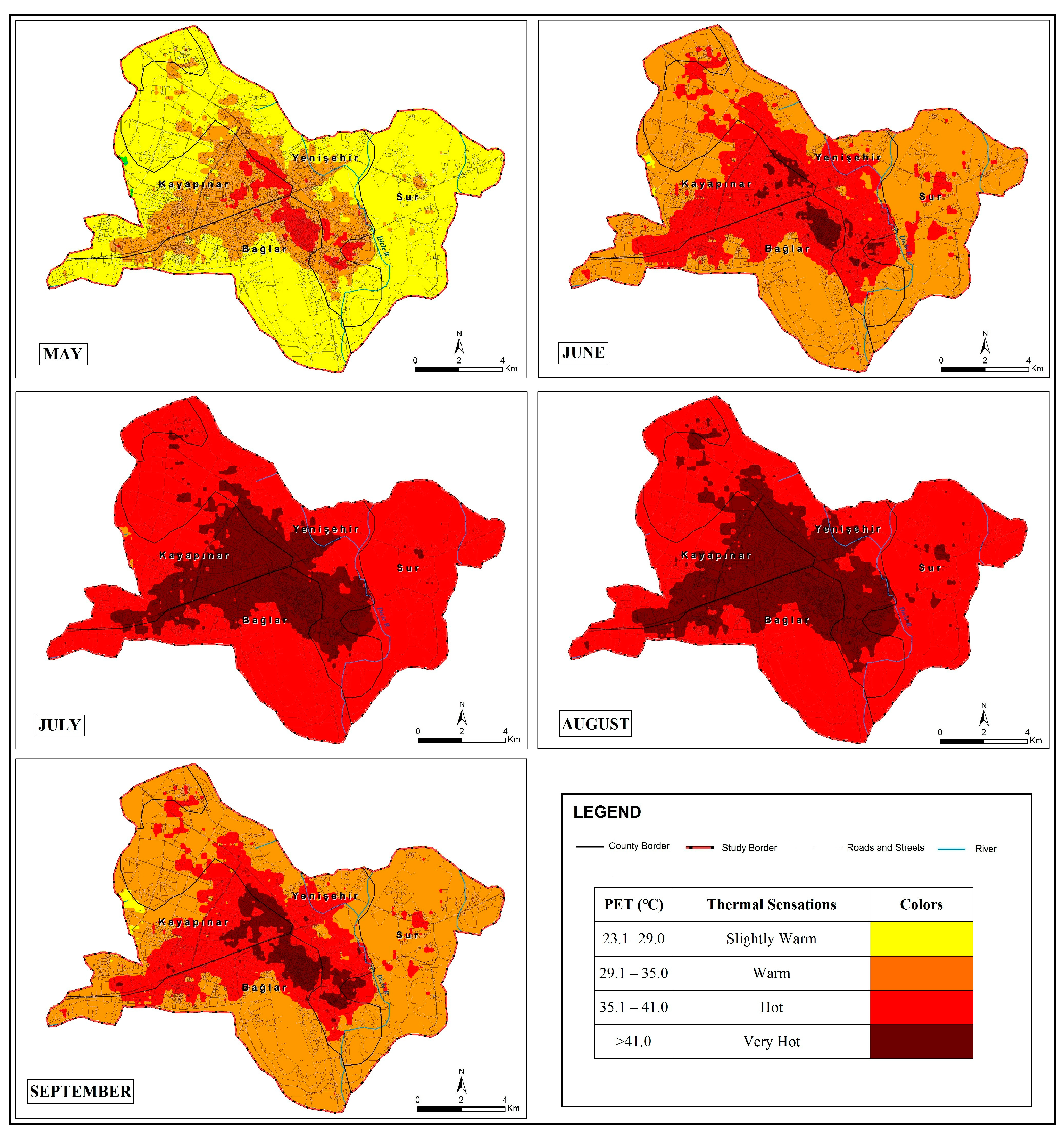

| Parameters | Value | Date/Period |
|---|---|---|
| Mean air temperature | 15.9 °C | Annual |
| Maximum air temperature | 38.4 °C | July |
| Minimum air temperature | −2.2 °C | January |
| Relative humidity | %55.2 | Annual |
| Wind velocity | 1.1 m/s | Annual |
| Total precipitation | 494.4 mm | Annual |
| Number of rainy days | 93.9 days | Annual |
| Extreme high temperature | 46.2 °C | 27 July 1937 |
| Extreme low temperature | −24.2 °C | 11 March 1933 |
| Highest rainfall in a day | 71.6 mm | 26 March 1976 |
| Highest snow thickness | 65 cm | 16 January 1973 |
| Extreme wind | 35 m/s | 1 June 1987 |
| Represented Area | Code | Location | Altitude (m) | Surface |
|---|---|---|---|---|
| U | 17281 | 37°54′33.01″ N; 40°12′52.89″ E | 680 | Dense structured |
| SU | 18166 | 37°55′27.48″ N; 40°13′58.43″ E | 679 | Loosely structured |
| SU | 17283 | 37°56′19.57″ N; 40°17′48.37″ E | 701 | Loosely structured |
| R | 17280 | 37°54′0.49″ N; 40°12′21.16″ E | 674 | No structure |
| PET (°C) | Thermal Sensation | Level of Thermal Stress |
|---|---|---|
| <4.0 | Very cold | Extreme cold stress |
| 4.1–8.0 | Cold | Strong cold stress |
| 8.1–13.0 | Cool | Moderate cold stress |
| 13.1–18.0 | Slightly cool | Slightly cold stress |
| 18.1–23.0 | Comfortable | No thermal stress |
| 23.1–29.0 | Slightly warm | Slightly heat stress |
| 29.1–35.0 | Warm | Moderate heat stress |
| 35.1–41.0 | Hot | Strong heat stress |
| >41.0 | Very Hot | Extreme heat stress |
| Variables | Alteration | PET (°C) |
|---|---|---|
| Wind velocity | 1 (m/s) | 2.50 |
| Mean radiant temperature (MRT) | 1 °C | 0.6 |
| Elevation | 100 (m) | 0.5 |
| Solar radiation (14:00 p.m.) | 100 (w/m2) | 0.4 |
| Solar radiation (07:00 a.m.) | 100 (w/m2) | 1.2 |
| Urban Land Cover | Present (2020) | Near Future (2050) | Distant Future | ||
|---|---|---|---|---|---|
| SSP-2 | SSP-5 | SSP-2 | SSP-5 | ||
| Continuous urban fabric (S.L.: >80%) | 16% | 19% | 23% | 25% | 32% |
| Discontinuous urban fabric (S.L.: 50%) | 52% | 52% | 51% | 50% | 45% |
| Rural area | 32% | 29% | 26% | 25% | 23% |
| Months/Ranges | Present (2015–2021) | Near Future (2021–2050) | Distant Future (2071–2100) | ||||||||||||||||||||
|---|---|---|---|---|---|---|---|---|---|---|---|---|---|---|---|---|---|---|---|---|---|---|---|
| SSP-2 | SSP-5 | SSP-2 | SSP-5 | ||||||||||||||||||||
| Comfortable | Slightly Warm | Warm | Hot | Very Hot | Comfortable | Slightly Warm | Warm | Hot | Very Hot | Comfortable | Slightly Warm | Warm | Hot | Very Hot | Slightly Warm | Warm | Hot | Very Hot | Slightly Warm | Warm | Hot | Very Hot | |
| M | 17 | 73 | 10 | 9 | 75 | 16 | 1 | 76 | 20 | 2 | 70 | 25 | 5 | 61 | 34 | 6 | |||||||
| J | 30 | 55 | 15 | 8 | 70 | 22 | 2 | 70 | 27 | 1 | 63 | 34 | 3 | 46 | 49 | 6 | |||||||
| J | 30 | 57 | 13 | 7 | 75 | 18 | 1 | 79 | 20 | 74 | 26 | 67 | 33 | ||||||||||
| A | 7 | 76 | 17 | 1 | 75 | 23 | 72 | 28 | 68 | 32 | 57 | 43 | |||||||||||
| S | 23 | 61 | 16 | 12 | 68 | 17 | 3 | 3 | 70 | 21 | 4 | 1 | 66 | 26 | 7 | 50 | 40 | 10 | |||||
Disclaimer/Publisher’s Note: The statements, opinions and data contained in all publications are solely those of the individual author(s) and contributor(s) and not of MDPI and/or the editor(s). MDPI and/or the editor(s) disclaim responsibility for any injury to people or property resulting from any ideas, methods, instructions or products referred to in the content. |
© 2023 by the authors. Licensee MDPI, Basel, Switzerland. This article is an open access article distributed under the terms and conditions of the Creative Commons Attribution (CC BY) license (https://creativecommons.org/licenses/by/4.0/).
Share and Cite
Çağlak, S.; Türkeş, M. Spatial Distribution and Future Projections of Thermal Comfort Conditions during the Hot Period of the Year in Diyarbakır City, Southeastern Turkey. Sustainability 2023, 15, 10473. https://doi.org/10.3390/su151310473
Çağlak S, Türkeş M. Spatial Distribution and Future Projections of Thermal Comfort Conditions during the Hot Period of the Year in Diyarbakır City, Southeastern Turkey. Sustainability. 2023; 15(13):10473. https://doi.org/10.3390/su151310473
Chicago/Turabian StyleÇağlak, Savaş, and Murat Türkeş. 2023. "Spatial Distribution and Future Projections of Thermal Comfort Conditions during the Hot Period of the Year in Diyarbakır City, Southeastern Turkey" Sustainability 15, no. 13: 10473. https://doi.org/10.3390/su151310473
APA StyleÇağlak, S., & Türkeş, M. (2023). Spatial Distribution and Future Projections of Thermal Comfort Conditions during the Hot Period of the Year in Diyarbakır City, Southeastern Turkey. Sustainability, 15(13), 10473. https://doi.org/10.3390/su151310473





